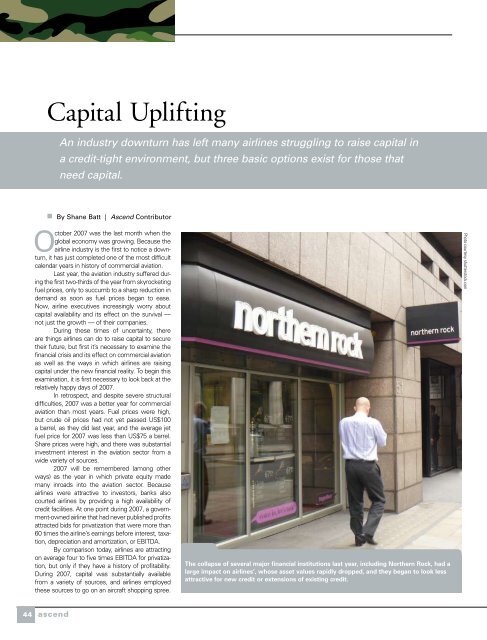2009 Issue 1 - Sabre Airline Solutions
2009 Issue 1 - Sabre Airline Solutions
2009 Issue 1 - Sabre Airline Solutions
You also want an ePaper? Increase the reach of your titles
YUMPU automatically turns print PDFs into web optimized ePapers that Google loves.
Capital Uplifting<br />
An industry downturn has left many airlines struggling to raise capital in<br />
a credit-tight environment, but three basic options exist for those that<br />
need capital.<br />
By Shane Batt | Ascend Contributor<br />
October 2007 was the last month when the<br />
global economy was growing. Because the<br />
airline industry is the first to notice a downturn,<br />
it has just completed one of the most difficult<br />
calendar years in history of commercial aviation.<br />
Last year, the aviation industry suffered during<br />
the first two-thirds of the year from skyrocketing<br />
fuel prices, only to succumb to a sharp reduction in<br />
demand as soon as fuel prices began to ease.<br />
Now, airline executives increasingly worry about<br />
capital availability and its effect on the survival —<br />
not just the growth — of their companies.<br />
During these times of uncertainty, there<br />
are things airlines can do to raise capital to secure<br />
their future, but first it’s necessary to examine the<br />
financial crisis and its effect on commercial aviation<br />
as well as the ways in which airlines are raising<br />
capital under the new financial reality. To begin this<br />
examination, it is first necessary to look back at the<br />
relatively happy days of 2007.<br />
In retrospect, and despite severe structural<br />
difficulties, 2007 was a better year for commercial<br />
aviation than most years. Fuel prices were high,<br />
but crude oil prices had not yet passed US$100<br />
a barrel, as they did last year, and the average jet<br />
fuel price for 2007 was less than US$75 a barrel.<br />
Share prices were high, and there was substantial<br />
investment interest in the aviation sector from a<br />
wide variety of sources.<br />
2007 will be remembered (among other<br />
ways) as the year in which private equity made<br />
many inroads into the aviation sector. Because<br />
airlines were attractive to investors, banks also<br />
courted airlines by providing a high availability of<br />
credit facilities. At one point during 2007, a government-owned<br />
airline that had never published profits<br />
attracted bids for privatization that were more than<br />
60 times the airline’s earnings before interest, taxation,<br />
depreciation and amortization, or EBITDA.<br />
By comparison today, airlines are attracting<br />
on average four to five times EBITDA for privatization,<br />
but only if they have a history of profitability.<br />
During 2007, capital was substantially available<br />
from a variety of sources, and airlines employed<br />
these sources to go on an aircraft shopping spree.<br />
44 ascend<br />
the collapse of several major financial institutions last year, including Northern rock, had a<br />
large impact on airlines’, whose asset values rapidly dropped, and they began to look less<br />
attractive for new credit or extensions of existing credit.<br />
Photo courtesy shutterstock.com
















